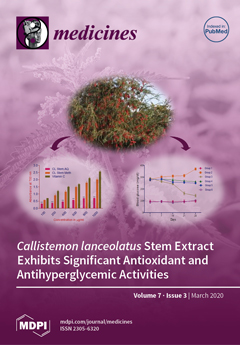Background: Clausena indica fruit is commonly used for food ingredients and traditional medicines in tropical countries, however, information about its biological activities and chemical profiles has been inadequately reported.
Methods: In this study, a bio-guided fractionation of antioxidants and α-amylase inhibitors from hexane
[...] Read more.
Background: Clausena indica fruit is commonly used for food ingredients and traditional medicines in tropical countries, however, information about its biological activities and chemical profiles has been inadequately reported.
Methods: In this study, a bio-guided fractionation of antioxidants and α-amylase inhibitors from hexane (MH) and ethyl acetate (ME) extracts of
C. indica fruit (pericarp and seed) was carried out. Eleven fractions from MH (D1–D11) and 17 fractions from ME (T1–T17) were obtained from column chromatography over silica gel, which were then examined for anti-radical capacity by 2,2-diphenyl-1-picrylhydrazyl (DPPH) and 2,2′-azinobis-(3-ethylbenzothiazoline-6-sulfonic acid) (ABTS) assays, and pancreatic α-amylase inhibition, a key enzyme linked to type 2 diabetes.
Results: Of isolated fractions, the fraction T4 revealed the most potent anti-DPPH activity (IC50 = 0.13 mg/mL), whereas T2 exhibits the strongest ABTS cation scavenging ability (IC50 = 0.31 mg/mL). In the enzymatic assay, the fractions D3 and T4 significantly inhibit the α-amylase reaction with IC50 values of 0.34 and 0.86 mg/mL, respectively. Remarkably, α-amylase suppression of T4 is close to acarbose and over four times stronger than palmitic acid, which are the well-known α-amylase inhibitors (IC50 = 0.07 and 1.52 mg/mL, respectively). The active constituents from fractions were identified by gas chromatography-mass spectrometry (GC-MS). The results show that the fraction D3 contains five major compounds, which are grouped in five classes consisting of fatty acids, phenols, benzodioxoles, alcohols, and sesquiterpenes. Among them, palmitic acid is the most dominant compound (32.64%), followed by 2R-acetoxymethyl-1,3,3-trimethyl-4t-(3-methyl-2-buten-1-yl)-1t-cyclohexanol (16.69%). Whilst, six major compounds belonging to fatty acid and coumarin classes are identified in the fraction T4. The most abundant compound in T4 is dentatin (47.32%), followed by palmitic acid (15.11%).
Conclusions: This is the first finding that
C. indica fruit can be a promising source for the development of natural antioxidant and antidiabetic agents. Additionally, the outcome reveals that dentatin, a known natural antineoplastic agent, can be feasibly exploited from
C. indica fruit.
Full article




